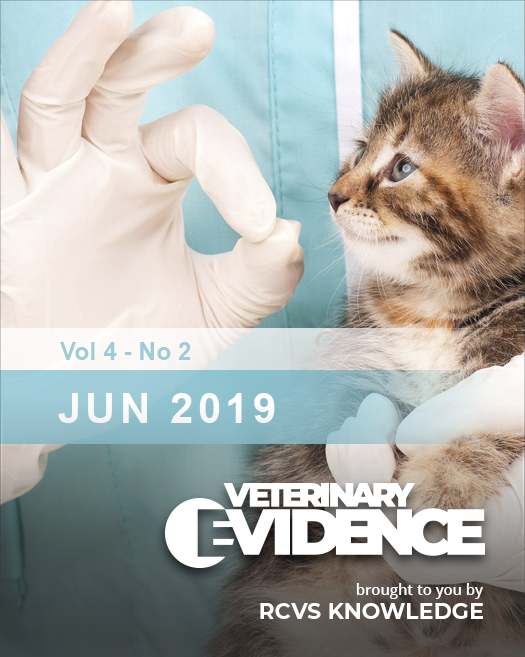DOI
https://doi.org/10.18849/ve.v4i2.163Abstract
PICO question
In dogs and cats, is the oral administration of garlic, compared to no treatment, efficacious at preventing or reducing the intestinal worm burden (species found in the UK)?
Clinical bottom line
No studies were identified that investigated the efficacy of garlic at preventing intestinal worm burden. Garlic reduced egg and/or larvae counts in the worm species studied. However, where measured, egg and larvae count rapidly (2 days) returned to pretreatment levels once dietary garlic was discontinued. None of the studies included adulticidal action as an outcome measure. In the absence of research to demonstrate high levels of adulticidal action against a range of intestinal wormers at therapeutic, non-toxic levels in cats and dogs, clients should be advised that garlic has not been demonstrated to be an effective anthelmintic (either for multiple or single species use) for use in dogs and cats either to prevent or to treat an intestinal worm burden.
![]()
![]()
References
Andrei, S., Ilie, M. S., Mederle, N. & Darabus, G. (2011) Testing the effectiveness of a plant extract in the therapy on some endoparasites in dogs. Lucrari Stiintifice - Medicina Veterinara, Universitatea de Stiinte Agricole si Medicina Veterinara "Ion Ionescu de la Brad" Iasi, 54(3), pp. 247–254.
Bartha, S. G., Quave, C. L., Balogh, L., Papp, N. (2015) Ethnoveterinary practices of Covasna County, Transylvania, Romania. Journal of Ethnobiology and Ethnomedicine 11: 35 [online] Available from: https://ethnobiomed.biomedcentral.com/articles/10.1186/s13002-015-0020-8 (accessed: 16/05/2019) DOI: http://dx.doi.org/10.1186/s13002-015-0020-8
Bastidas, G. J. (1969) Effect of ingested garlic on Necator americanus and Ancylostoma caninum. The American Journal of Tropical Medicine and Hygiene, 18(6), pp. 920–923. DOI: http://dx.doi.org/10.4269/ajtmh.1969.18.920
Bekirov, R. E., Azimov, Sh. A., Oripov, A. O., & Dzhumaev, Z. (1979) The efficacy of granules against cestodes in dogs. Veterinariya, Moscow 8, pp. 50–51.
Bullitta, S., Re, G. A., Manunta, D. I., & Oiluzza, G. (2018) Traditional knowledge about plant, animal, and mineral-based remedies to treat cattle, pigs, horses, and other domestic animals in the Mediterranean island of Sardinia. Journal of Ethnobiology and Ethnomedicine 14: 50 [online] Available from: https://ethnobiomed.biomedcentral.com/articles/10.1186/s13002-018-0250-7 (accessed: 16/05/2019) DOI: http://dx.doi.org/10.1186/s13002-018-0250-7
Buona, F., Pacifico, L., Piantedosi, D., Sgroi, G., Neola, B., Roncoroni, C., Genovese, A., Rufrano, D., & Veneziano, V. (2019) Preliminary Observations of the Effect of Garlic on Egg Shedding in Horses Naturally Infected by Intestinal Strongyles. Journal of Equine Veterinary Science 72: 79–83. DOI: http://dx.doi.org/10.1016/j.jevs.2018.10.025
French, K. E. (2018) Plant-Based Solutions to Global Livestock Anthelmintic Resistance. Ethonobiology Letters 9(2): 110–123. DOI: http://dx.doi.org/10.14237/ebl.9.2.2018.980
Guarrera, P. M., Lucchese, F., & Medori, S. (2008) Ethnophytotherapeutical research in the high Molise region (Central-Southern Italy). Journal of Ethnobiology and Ethnomedicine 4: 7 [online] Available from: https://ethnobiomed.biomedcentral.com/articles/10.1186/1746-4269-4-7 (accessed: 16/05/2019) DOI: http://dx.doi.org/10.1186/1746-4269-4-7
Lans, C., Turner, N., Khan, T., Brauer, G., & Boepple, W. (2007) Ethnoveterinary medicines used for ruminants in British Columbia, Canada. Journal of Ethnobiology and Ethnomedicine 3: 11 [online] Available from: https://ethnobiomed.biomedcentral.com/articles/10.1186/1746-4269-3-11 (accessed: 16/05/2019) DOI: http://dx.doi.org/10.1186/1746-4269-3-11
O’Connor, A. (2017) Is the simplicity of the evidence pyramid actually detrimental for understanding evidence? Veterinary Evidence 2(1). DOI: http://dx.doi.org/10.18849/ve.v2i1.100
Orengo, K. O., Maitho, T., & Mbaria, J. 2016. In vitro anthelmintic activity of Allium sativum, Allium cepa and Jatropha curcas against Toxocara canis and Ancylostoma caninum. African Journal of Pharmacy and Pharmacology 10(21): 465–471.
Martin, L. K. & Beaver, P. C. (1968) Evaluation of Kato thick-smear technique for quantitative diagnosis of helminth infections. American Journal of Tropical Medicine and Hygiene 17, pp. 382–391. DOI: http://dx.doi.org/10.4269/ajtmh.1968.17.382
Palacious-Landin, J., Mendoza-de Gives, P., Salinas-Sanchez, D. O., Lopez-Arellano, M. E., Liebano-Hernadez, E., Hernadez-Velazquez, V. M., & Valladares-Cisneros, M. G. (2015) In vitro and in vivo nematocidal activity of Allium sativum and Tagetes erecta extracts Against Haemonchus contortus. Turkish Journal of Parasitology 31: 277–282. DOI: http://dx.doi.org/10.5152/tpd.2015.4523
Ronagh, K., Gharouni, A., Bahadori, S. R., Zakian, A., Gholami, N., Rezaeian, H. & Shahraki, M. S. (2015) Effect of Nigella sativa, Allium sativum, Syzgium aromaticum and Cucurbita maxima on Toxocara cati fecal egg count in stray cats. Online Journal of Veterinary Research, 19(5), pp. 325–330.
Tavassoli, M., Jalilzadeh-Amin, G,. Fard, V. R. B., & Esfandiarpour, R. 2018. The in vitro effect of Ferula asafoetida and Allium sativum extracts on Strongylus spp. Annals of Parasitology 64(1): 59–63.
Velkers, F. C., Dieho, K., Pecher, F. W. M., Vernooij, J. C. M., van Eck, J. H. H., &Landman, W. J. M. (2011) Efficacy of allicin from garlic against Ascaridia galli infection in chickens. Poultry Science 90(2): 364–368. DOI: http://dx.doi.org/10.3382/ps.2010-01090
Worku, M., Franco, R., & Baldwin, K. (2009) Efficacy of garlic as an anthelmintic in adult Boer goats. Archives of Biological Sciences 61(1): 135–140. DOI: http://dx.doi.org/10.2298/ABS0901135W
License
Copyright (c) 2019 Louise Anne Buckley

This work is licensed under a Creative Commons Attribution 4.0 International License.
Veterinary Evidence uses the Creative Commons copyright Creative Commons Attribution 4.0 International License. That means users are free to copy and redistribute the material in any medium or format. Remix, transform, and build upon the material for any purpose, even commercially - with the appropriate citation.
Most read articles by the same author(s)
- Louise Buckley, Josie Lees, Go Slow Feeding Bowls: How Effective Are They at Getting Dogs to Eat More Slowly? , Veterinary Evidence: Vol. 1 No. 4 (2016): Our fourth issue
- Ellie Sellers, Sarah Baillie, Rachel Dean , Sheena Warman, Heidi Janicke, Sebastian P Arlt, Clare Boulton, Marnie Brennan, David Brodbelt, Fiona Brown, Louise Buckley, Myai Du, Emma Gallop, George Goran, Douglas JC Grindlay, Laura Haddock, Joanne Ireland, Catherine McGowan, Heather K Moberly, Emma Place, Md Mizanur Rahman, Gwen Rees, Kristen Reyher, Javier Sanchez, Johan P Schoeman, Laura Urdes, John VanLeeuwen, Kristien Verheyen, Promoting Evidence-based Veterinary Medicine through the online resource ‘EBVM Learning’: User feedback , Veterinary Evidence: Vol. 6 No. 1 (2021): The first issue of 2021
